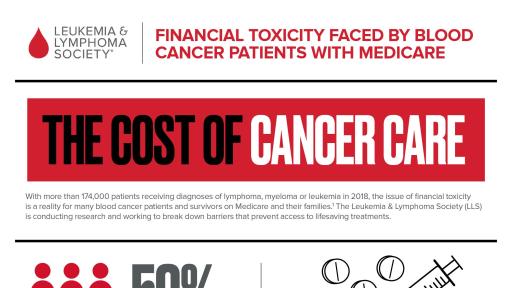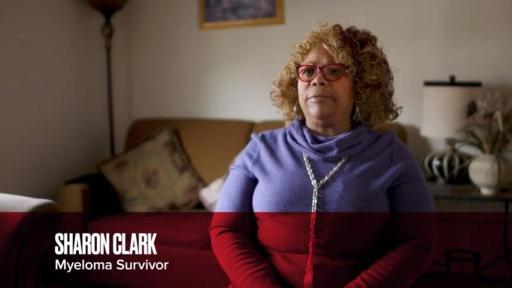Nearly 60 Percent Of Blood Cancer Patients Covered By Medicare Delay Or Forgo Treatment; One Factor Could Be The High Cost Of Cancer Care
A new study commissioned by The Leukemia & Lymphoma Society finds that patients can still face steep out-of-pocket costs three years after initial diagnosis; consumers should closely consider their coverage options during open enrollment
Rye Brook, N.Y. (October 21, 2019) – Survival of older patients with blood cancers continues to improve as more effective, less toxic therapies are introduced. However, these lifesaving treatments often are expensive and many cancer patients face financial burdens caused by ever-increasing healthcare costs. In fact, according to a new study released today by The Leukemia & Lymphoma Society (LLS), 59 percent of surviving blood cancer patients enrolled in traditional Medicare do not begin active treatment within three months of their diagnosis. Many factors likely contribute to these delays or foregoing of treatment, but given the study findings on the high cost of treatment for patients, LLS believes that cost could be a key driving factor in these patients’ behavior.
The study “The Cost Burden of Blood Cancer Care in Medicare,” commissioned by LLS from Milliman, identifies factors driving costs to the healthcare system and impacting patients. It also sheds light on the out-of-pocket cost burden associated with cancer treatment for blood cancer patients.
“In addition to the emotional impact of dealing with a blood cancer, patients and families often face extraordinary costs in the first year after diagnosis and beyond,” said Louis J. DeGennaro, Ph.D., LLS president and CEO. “The Leukemia & Lymphoma Society hopes that the findings from this new study will prompt payers, providers, patient advocates and policymakers to work together to address the financial burdens for patients.”
Results of a study LLS previously commissioned from Milliman looked at the cost burden for blood cancer patients covered by commercial insurance plans. The study, released last October, found that the average costs of treating blood cancer patients are higher than those of treating patients with other types of cancers. As well, those costs for many blood cancer patients do not return to pre-diagnosis levels even three years or more after diagnosis. Patient out-of-pocket costs for blood cancer care averaged thousands of dollars per year and were strongly influenced by the patient’s insurance plan. Information from that study can be found here.
Highlights of Milliman Study on Medicare Patients
First-year out-of-pocket treatment costs are high for some patients. According to the study, some traditional Medicare lymphoma patients who receive anti-cancer therapy though infusions experienced out-of-pocket costs of more than $19,000 in their first year. For some acute leukemia patients, enrolled in traditional Medicare and on infused anti-cancer therapy, out-of-pocket costs were more than $16,000 in the same period. Although supplemental coverage lowers cost-sharing for some patients on infused therapies, Kaiser Family Foundation reports that one of four Medicare beneficiaries has no such coverage.
Costs can extend two or three years beyond a blood cancer diagnosis. The study found also that many patients face high costs after their first year of treatment. This is often the case for patients who require ongoing treatment for their blood cancer, such as those who take a daily anti-cancer pill for the rest of their lives. Findings show that after two years, patients newly diagnosed with multiple myeloma in traditional Medicare incurred cumulative out-of-pocket costs averaging nearly $24,000. After three years, those with chronic leukemia had the lowest cumulative out-of-pocket costs among all blood cancer patients, averaging more than $15,000. While this figure is less than the cumulative expenses incurred by multiple myeloma patients and others affected by blood cancer, out-of-pocket costs such as these pose a financial burden for many patients.
LLS’s Perspective & Recommendations
Ever-increasing cancer treatment costs can strain and potentially threaten the Medicare program. The cost of treating blood cancer is significantly higher than the costs associated with treating many other cancers and other complex diseases. Without focused action to address high costs, there will be a strain on the Medicare trust fund that can threaten the stability of the program for future generations. As well, insurance programs like Medicare too often respond to increased treatment costs by erecting barriers to care, such as increasing cost-sharing and limiting access to certain cancer centers and providers, that lower cost at the expense of patient access.
What to consider during the Medicare open enrollment period. Medicare open enrollment runs from now until December 7. LLS recommends that Medicare-eligible patients and their families closely examine all of their options for Medicare coverage. If a patient has or expects to have high hospital and doctors’ office costs, they might want to consider Medicare Advantage plan options that feature an out-of-pocket cap on certain health costs such as infused drug coinsurance and doctor visit copays.
LLS received limited support for this work from Genentech, Inc. & Biogen; Pharmacyclics, An AbbVie Company & Janssen Biotech; and Takeda Oncology.
LLS is committed to easing the cost of cancer care for patients, and calls on policymakers to address this critical issue by advancing the policy changes most likely to drive down costs. In March, LLS urged Congress to cap out-of-pocket costs for cancer patients enrolled in Medicare Part D, a recommendation recently endorsed by all House and Senate committee leaders. This research underscores the need for policymakers to extend out-of-pocket cost protections to all patients, regardless of how they access their care.
Patients, families and caregivers affected by blood cancer can turn to LLS for free emotional, educational and financial support. Information about the support services LLS provides can be found here.
To learn more about the challenges patients face and what LLS is doing to drive change, please visit http://www.lls.org/cancercost.
About The Leukemia & Lymphoma Society
The Leukemia & Lymphoma Society® (LLS) is a global leader in the fight against cancer. The LLS mission: Cure leukemia, lymphoma, Hodgkin’s disease and myeloma, and improve the quality of life of patients and their families. LLS funds lifesaving blood cancer research around the world, provides free information and support services, and is the voice for all blood cancer patients seeking access to quality, affordable, coordinated care.
Founded in 1949 and headquartered in Rye Brook, NY, LLS has chapters throughout the United States and Canada. To learn more, visit www.LLS.org. Patients should contact the Information Resource Center at (800) 955-4572, Monday through Friday, 9 a.m. to 9 p.m. ET.
For additional information visit lls.org/lls-newsnetwork. Follow us on Facebook, Twitter, and Instagram.
About Milliman
Milliman is among the world’s largest providers of actuarial and related products and services. The firm has consulting practices in healthcare, property & casualty insurance, life insurance and financial services, and employee benefits. Founded in 1947, Milliman is an independent firm with offices in major cities around the globe. For further information, visit www.milliman.com.
Media Contacts:
Andrea Greif
[email protected]
914-821-8958
Melissa Valentino
[email protected]
914-821-8389
Additional LLS Findings about Medicare
In addition to the new Milliman report on Medicare costs, The Leukemia & Lymphoma Society (LLS) along with The Commonwealth Fund supported a recent study led by Stacie Dusetzina, Ph.D., Associate Professor of Health Policy and Ingram Associate Professor of Cancer Research at Vanderbilt University School of Medicine, who investigates drug policies and prices. The initial findings of Dusetzina’s study, featured in The Journal of the American Medical Association support some of those revealed in the new Milliman report commissioned by LLS.
The findings from both studies show there is an urgent need to reform Medicare’s out-of-pocket requirements for costly drugs. Notably, out-of-pocket costs have risen for patients relying on specialty tier drugs, particularly for oral anticancer medications.
Dusetzina notes that increases in drug costs occurred despite an Affordable Care Act change that closed the so-called “donut hole” in Part D. While this change was expected to provide relief for patients on costly drugs, those savings have been eclipsed by increased out-of-pocket costs outside the donut hole. As a result, patients pay more today for cancer drugs than they did before Congress closed the donut hole. “The average price for orally-administered anticancer drugs on Medicare Part D today is nearly $14,000 per fill. This can leave patients paying thousands of dollars for their first fill and, in some cases, over $1,000 per fill in the catastrophic coverage phase of the benefit.”
Congress is currently debating several reforms to address this problem. House and Senate leaders in both parties have proposed to cap total annual out-of-pocket costs in Medicare Part D, and Congress is considering incorporating a policy that protects patients from paying their total annual cost-sharing at a single trip to pharmacy. Congress is also considering several policies that would significantly lower the total cost of prescription drugs in Medicare and other insurance plans, as well as reforms that would eliminate tactics used by some drug makers to keep lower-cost alternatives off the market.
Another LLS study published in the New England Journal of Medicine, also led by Dusetzina examines three proposed redesigns to the Medicare system and recommends that “solutions should target people with the highest out-of-pocket spending by introducing an out-of-pocket spending cap,” and that “Medicare could do more to directly address drug prices — both high prices at launch and price increases over time — in Part D.”




